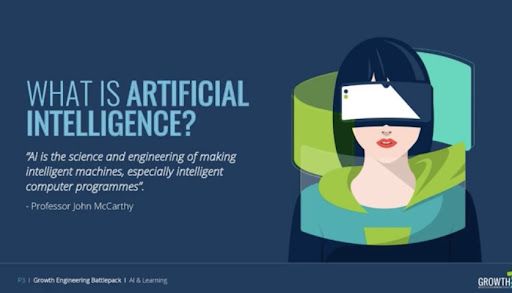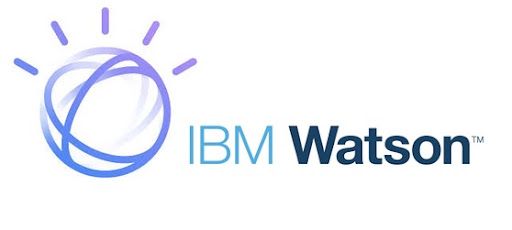My name is Juliette Denny, and I am the CEO at Growth Engineering. We create really engaging technology fueled by artificial intelligence.
Now, I know this subject can seem like traveling to an alien planet, but I’m giving you a step-by-step guide to reach lift-off!
Here’s the breakdown: 👇
Main talking points
- What is AI
- AI in more detail
- Hollywood has warped our understanding
- Business applications
- Unprecedented growth
- Better outcomes
What is AI?
There’s a number of different definitions of AI. But none of them define it better than this quote from Professor John McCartney.

In other words, AI represents our efforts to stimulate human intelligence through machines. AI in SaaS is usually applied to automate tasks or processes to make them more efficient.
These are the more challenging tasks that humans would do, rather than easier tasks. An important thing to note right off the bat, is that AI isn't a substitute for human activity; it augments human activity.
AI can take over tasks that would be more time-consuming for a person, like looking through legal documents to find precedents and commonality. On the other hand, things that're easy for human beings, like walking, are very hard for AI to pull off.
Okay, so now that we’ve got the definitions out of the way, let's dig into AI in a little more detail.
AI in more detail
Now, within the subject of AI, there are many subcategories, and we’re going to cover them in this section.
Weak/narrow AI
Typically, when people are talking about weak or narrow AI, it's the type of artificial intelligence that's limited to a really specific or narrow area. So, for example, we have Alpha Zero. That's a computer system that’s basically excellent at chess. But if you were going to bet on this system in a game of Scrabble, you’d be out of luck.
General AI
This system seeks to establish a kind of intellectual agent that can learn any top tasks that humans can. In other words, it’s on par with a human ability. This has been used when assessing loan criteria, for example, whether something is low or high risk.
Super AI
As you may have guessed by the title, super AI would be something that has superseded human intelligence. The potential of these kinds of technologies is unprecedented (and potentially scary!) It’ll probably be a long time before we arrive at this point.
Machine learning
This is a subfield of the wider AI. It allows the software to learn through an algorithm so that it can complete tasks more efficiently.
Deep learning
This is a type of machine learning that uses artificial neural networks. It progressively learns from the data that's being pushed through the neural network. This is a textbook example of AI augmenting human actions.
Hollywood has warped our understanding
Sadly (or maybe luckily!) we’re not anywhere close to Terminator 2 or Ex Machina.
Better examples
Modern-day examples of AI include things like:
- Recommendation engines
- Virtual assistants
- Chatbox
- Intelligent Search
- Email filtering
- Driverless cars
All of these are powered by AI. Now, we've highlighted some modern examples of AI, let’s look at some companies that have invested heavily in AI.
Business applications

Domino's
So, I don’t know about you, but I love pizza, but do you know what I didn't love? Ordering pizza on my cell phone for deliveries. Often you’d be waiting there, not knowing what time it was going to arrive, wondering if they’d forgotten about it even!
What Domino's pizzas did is they used artificial intelligence to develop a model which allowed them to predict when your pizza was going to get to you. They went from an accuracy of 75% to an accuracy of 95%. This also worked out well for Domino’s because it meant they weren’t getting as many calls.

Deutsche Bank
This company really utilizes AI in a different way. They used it to identify attractive loan clients to speed up their loan approvals. This happens as the customer is actually filling in the form, and it's really speedy and efficient. Just think about how much manpower and how much expense banks must rack up from having to employ people to carry out those checks!
The knock-on effect has been that more people have signed up to use this process. Now, more loans are getting approved, and more business is being done.

IBM Watson
IBM Watson has a number of applications in terms of customer service. They have a smart assistant, which uses conversational AI to help resolve over 7,000 customer inquiries a day. The reason why this works is that most of the customer inquiries are the same customer inquiries, it doesn't require human intervention, so we're driving down the cost of delivering the service.
Real breakthroughs
Having said that, there are also really powerful examples of AI. It has the potential to engineer unthinkable technology, as well as technological and scientific breakthroughs. Because machines are able to analyze data so much quicker than mortal brains.
A good recent example would be…

Deep Mind
Deep Mind's AI program was able to solve a problem that scientists have been trying to crack for almost 50 years. Now, I'm no protein scientist, but what a protein does largely depends on its own unique 3D structure. Understanding how different proteins can fold can really help us develop new medical treatments.
It represents a real, significant advance in human understanding. Because scientists were unable to understand how the math worked, It was estimated that it would never be known.
But of course, Alphafold came to the rescue! It’s a software from DeepMind that’s able to analyze the available data. It then develops really strong predictions of the underlying physical structure of the protein within a matter of days.
Unprecedented growth in AI
A lot of large organizations are investing in AI. If you're a small or medium-sized business, never think that you are locked out of AI, because the reality is, there has been a huge amount of investment made by the big technology companies. And now this technology is widespread. It’s very accessible to smaller companies.
Don’t believe me? Here are some key stats on the growth of AI:
- 97.2% of organizations are now investing in AI (NewVantage Partners)
- AI tech investment will reach $232 billion by 2025 (KPMG)
- AI will contribute $15.7 trillion to the world economy by 2030 (PwC)
Why should AI be so interesting to you? Well, first…
It automates time-consuming tasks
Let's say in customer success, for example, they're answering the same questions over and over again. By utilizing bots, you can speed up the time that you can respond to customers.
When you usa a customer support helpline, you’ll typically encounter a bot filtering out the common questions before they put you in touch with a human being.
AI increases team efficiency
Your team is freed up from answering the same question over and over again. They can work on more challenging questions, and they can really formulate creative ways to innovate, do their jobs, and deliver value for the customer.
Is AI going to replace humans?
This is really the million-dollar question, right? But the reality is, it’s really not true at all. Robots are not going to replace humans, they're going to make human jobs more humane.
Robots will be doing the four Ds in jobs. These are:
- Jobs that are more difficult
- Jobs that are more demeaning
- Jobs that are more demanding
- Jobs that are more dangerous
Humans get to be the superheroes

They can get creative and really focus on solving complex problems, those wonderful things robots will never be able to do. What we really should be doing is trying to advance AI and machine learning to take over stuff that we really don't want to be doing ourselves.
What we do at Growth Engineering
The first thing is, we are not a big company. We're working on a shoestring budget to produce something which is really meaningful. Humans are naturally curious, but sometimes when it comes to doing online learning, we stop being curious.
Our main goal is to determine how we can get AI to facilitate learning being easier. Here are some of the ways that we think can achieve that:
AI can automate tedious admin tasks
When you join a Learning Technology Department, you don't join because you want to work a learning management system or create e-learning, you join because you love training people. So, one of the things that we really wanted to do is enable L&D professionals to focus on what they love doing, which is developing people.
How can we utilize AI for account provisioning, user provisioning, etc?
AI can create personalized learning pathways
Think about your Netflix recommendations – which are AI automated– how would you feel if it kept pushing the same content at you based on an algorithm? E-learning is the same. By freeing up people, we can allow them to curate pure curiosity and deliver the stuff our learners really want.
How can we refine learning?
One of the things that's really important in learning and development is showing that you can do something as well as know it. We want to make learners more than a passive recipient of a piece of content.
AI can help in getting people to practice the skills before they actually put it into practice.
We want to make it easy for admins to understand the process of learning.
We want them to understand that:
- You need to see the information.
- You need to be reminded of it through testing and assessments.
- You actually need to do it.
If we can pull together processes, AI can actually facilitate this for the admin, and we're going to get better outcomes.
Better outcomes
Example 1: recommendation engines
There are many big technology companies that have recommendation engines you can plug into really easily. All you need to do is Google AI and you will find a whole variety of different services that they offer. One of the things that they offer is recommendations engines.
What does that mean for us? Well, we need APIs that bring together our user-provisioning information with our content information in order to deliver good recommendations for our learners
Now, one of the challenges in this is that the model can only be trained once the user information is there. You need to have a cold start, but once you get going, one of the great things about recommendation engines is they focus very much on what colleagues in your industry are doing rather than the actual content itself.
Example 2: User & content provisioning
This is admittedly pretty boring, but it’s a massive part of onboarding.With our customers from big companies like L'Oréal and BT, the users and content they provision can come from five or six different enterprise platforms.
Not only that, the content can come from five or six different content providers, including their own content providers. We can end up with different elements of metadata in the information that we get. For users, we can get a lot of patchy information.
Often it's a real nightmare for some of our clients to be able to put the data in the structure. We need to onboard them and get the right recommendations in terms of content. What we've been able to do with AI is use auto-tagging.
This allows us to match between the content and the provisioning data in order to get the model started. It's not quite a cold start. We’re able to get between 56 to 70%, depending on how much information is coming over from the content metadata.
Example 3: Intelligent search
We need a deep intelligence search on our own platforms, as well as on the learning content itself. We need to do intelligent search on everything in the ecosphere of our customers, not just the information on our platform, Intelligent Search is a great way of doing that.
Using API's, you can easily push out to other platforms, get that information, and then bring it back to your users in whatever the user interfaces.
Example 4: Content Creation
Content creation is a massive headache! Most organizations have a huge amount of information that they need to get out to their people. Some of our biggest clients are in retail, and there are products coming all the time. You can have a situation where you've got to spend 180 hours creating a single hour of e-learning. Yeah, no-one has time for that, right?
AI can very easily upload PowerPoint presentations, upload work docs, upload PDFs, and then put it into a series of templates. Again, this frees up educators to do more actual educating. We’re in a situation where we’re able to coach people one-on-one in a more personalized manner.
Example 5: AI coaches and mentors
Okay, so let’s say we know what the correct curriculum is, if we push that into the AI engine, we create the content really quickly. Once students start asking questions, the AI can query it out, and find subject matter that answers these questions.
You're going to have some tutors there initially, but it could be a very personalized level of learning.
Ideas are cheap…delivery is expensive
This may be true, but let’s also remember that there is no delivery without ideas. You've got to start somewhere, right? We can't just all throw up our hands and say, “it's all too big! It's all too complicated. It's all too expensive.”
AI is absolutely not a mysterious planet that can only be visited by spacemen, or, in real world terms, the top five technology companies. It really should be the new bread and butter of any SaaS company.
At Growth Engineering, we're a very, very small company, but we’ve made AI and ML absolutely central to how we operate.
Everything that our department does is driving towards this idea of utilizing AI and ML where possible, in order to deliver more, for less. That mindset change is a really important part of moving towards AI.
The problem is always data
Don't think that your first thing you're going to be doing is building neural networks. The thing is, you don't have to. There are just so many free and open-source elements to try. Instead, the constraint is always data. If the problem is that you've got lots of replicable data, then you will very easily be able to find an AI or ML solution.
Find the thing that can be automated
Find the process within your organization that can be automated. Find out which of those processes you've got the most data for. If you don't have a large amount of data, then reach out to open source sites for code that's been written, and try and play around with it, if you can't find it for free.
There are lots of SaaS providers that have all the components you really need in order to plug your data for.
Find a pilot project
Finally, if you have exhausted the above, look at paying for a pilot project for a consultancy. This can be internal or it can be external. To be honest with you, I don't think you need to be putting in huge amounts of resources for actually building the model.
Key takeaways
- AI helps us to automate time-consuming tasks: Just imagine the much innovative, creative work your team can do when they're freed by AI!
- It has helped other industries to cut out costs and drive more value: It might seem like a big investment, but it’s more than worth it. Believe me.
- Intelligence is what makes us human: AI is just an extension of that.
AI is not going to take over our lives. If anything, it’s going to make our lives infinitely better.
Have fun!



